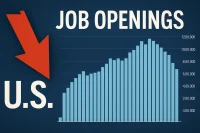Remote work is no longer a pandemic experiment—it has become a defining feature of the modern workforce. But the shift isn’t just about how people work; it’s also about where they choose to live.
A growing number of high-earning professionals, especially those in expensive states like California, are packing up and moving to smaller, more affordable communities across the United States. With six-figure salaries in hand and the flexibility of remote work, these professionals are fueling new patterns of migration that are already reshaping local economies, housing markets, and recruitment strategies.
The Trend: From Big Cities to Smaller Towns
- Why California? California remains one of the most expensive places to live in the U.S. Sky-high housing prices and the cost of living are pushing workers to explore alternatives.
- Who’s Moving? Primarily tech workers, engineers, marketers, and finance professionals earning six-figure salaries. These workers can maintain their income while lowering their living costs.
- Where Are They Going? Smaller cities and towns in the Midwest and South, often supported by incentive programs like MakeMyMove, which offer cash bonuses and community integration support for relocating professionals.
The result is an economic redistribution of talent and wealth from major coastal hubs to places once overlooked.
Programs Driving the Shift
MakeMyMove and Local Incentives
One standout program is MakeMyMove, which partners with communities to recruit remote workers. Incentives often include:
- Cash bonuses (sometimes up to $5,000).
- Access to local coworking spaces.
- Relocation assistance.
- Integration support, such as helping families connect with schools or healthcare providers.
For small towns, attracting even a handful of remote professionals means more local spending, higher tax revenue, and new opportunities to fill chronic shortages in critical roles like teaching and nursing.
Want to Attract Remote Workers to Your Community?
Post your job and tap into talent ready to relocate with programs like MakeMyMove.
Post a Job Now →Economic Impact on Local Communities
1. Boost to Local Economies
Remote workers bring high salaries but spend them locally—on housing, dining, and services. Small businesses in these towns benefit from a steady flow of new customers.
2. Filling Workforce Gaps
While remote workers may keep their “day jobs” with out-of-state employers, many contribute locally in other ways. For example, spouses may take on teaching or healthcare jobs, or professionals may start small businesses.
3. Pressure on Housing Markets
An influx of high-income professionals risks driving up housing prices in smaller communities. Without investment in housing supply, locals could face displacement.
Why Employers Support It
Employers are also watching this trend closely. For them:
- Remote flexibility helps retain top talent, even if workers relocate.
- Distributed workforces reduce pressure on expensive office leases.
- Expanding beyond big cities diversifies talent pools and reduces wage inflation in traditional hubs.
Ready to Build a Smarter, More Flexible Workforce?
Post your remote or hybrid jobs today and reach top talent beyond the big cities — while saving on overheads and staying competitive.
Post a Job Now →Challenges of the Shift
- Infrastructure Needs
Towns attracting remote workers must upgrade digital infrastructure like broadband and provide enough schools, clinics, and housing. - Community Integration
If new arrivals remain socially isolated, they may leave. Programs that foster integration are crucial. - Equity Concerns
High-salaried newcomers can unintentionally displace lower-income locals if housing supply lags.
Case Study: Indiana and the Midwest
Indiana has actively embraced remote worker recruitment. Cities like Bloomington and Muncie have offered relocation packages and emphasized quality-of-life perks. Early reports show increased tax revenue and small business growth, but also concerns about rising rents.
This reflects the balancing act many towns now face: attracting wealth while protecting affordability.
Looking Ahead
Remote migration is not just a trend—it is becoming a structural feature of the U.S. economy. Over the next decade, demographers expect:
- Continued movement from high-cost coastal cities to mid-sized inland ones.
- A rise in competition among towns and states to attract remote workers.
- Greater emphasis on blending relocation with community revitalization, not just short-term gains.
If managed well, the “remote worker wave” could rejuvenate struggling towns and spread opportunity more evenly across the country. But without careful planning, it could deepen housing crises in unexpected places.
FAQs
Q1: Why are high-earning Californians moving to smaller towns?
Because they can maintain six-figure incomes while dramatically lowering their cost of living. Remote work gives them the flexibility to live anywhere.
Q2: What is the MakeMyMove program?
It’s an incentive initiative that offers cash and support to remote workers who relocate to smaller communities, aiming to boost local economies.
Q3: What are the risks for local communities?
The main risks include rising housing costs, displacement of locals, and pressure on infrastructure like schools and healthcare.
Q4: Who benefits most from this trend?
Both the remote workers—who save money and gain lifestyle improvements—and the local communities, which enjoy new spending, tax revenue, and talent.
Conclusion
The movement of high-earning remote professionals from states like California to smaller towns is one of the most important employment trends of 2025. It signals how technology, flexibility, and economics are reshaping not just workplaces but communities themselves.
Handled wisely, it offers a win-win: workers gain affordability and lifestyle improvements, while towns gain new talent and revenue. But without careful planning on housing and integration, the risks of inequality and displacement loom large.




